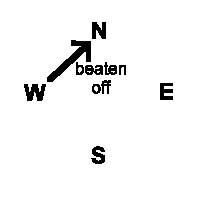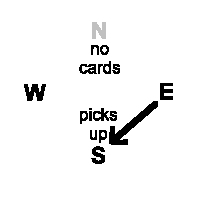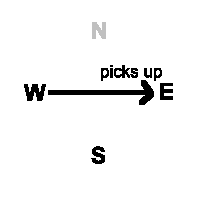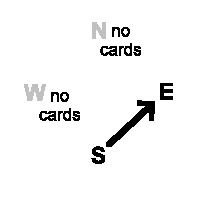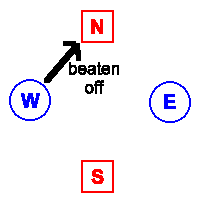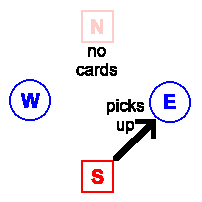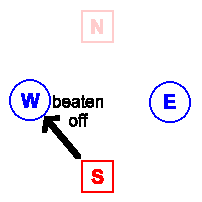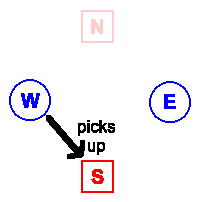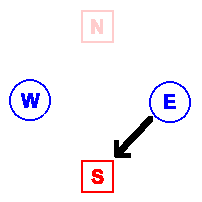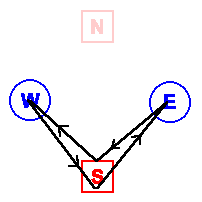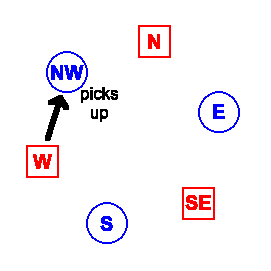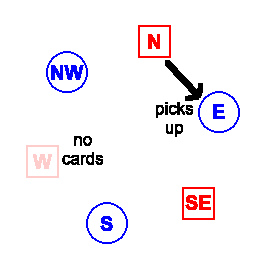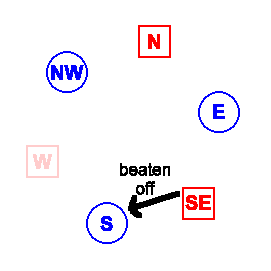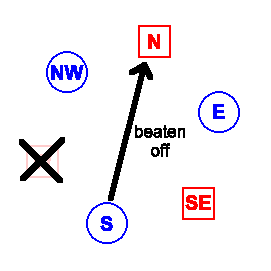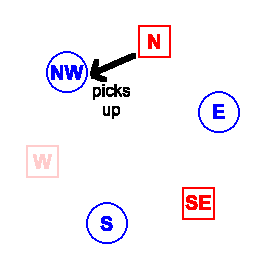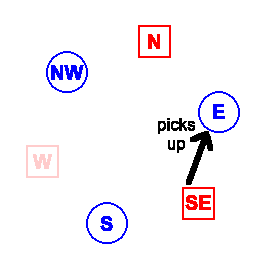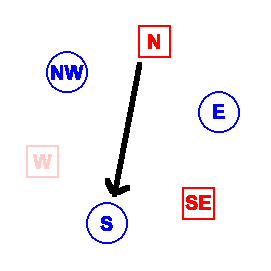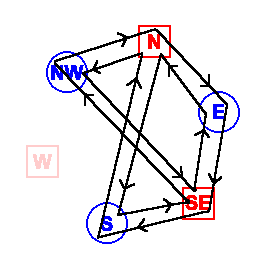Podkidnoy Durak
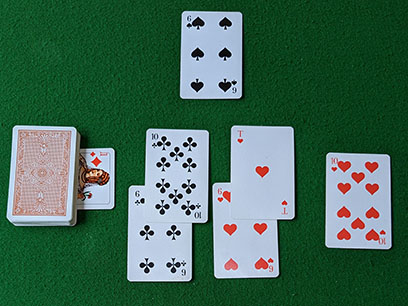
Durak is one of the best known card games in Russia and has spread to many east European countries. It can be played by 2-6 people and works well for 4 playing as partners.
Class: Beating games
Related games: Durak (Perevodnoy), Prostoy Durak
- Introduction
- Players
- Cards
- Objective
- Deal
- The Play
- The Result
- Variations
- Durak Severnyi
- Perevodnoy Durak
- Other durak WWW pages and software
Introduction
Durak is undoubtedly the most popular card game in Russia. It would hardly be an exaggeration to say that every Russian who plays cards knows this game. "Durak" means fool, the fool in this game being the loser - the player who is left with cards after everyone else has run out. The game described on this page is properly called "Podkidnoy Durak" (Подкидной Дурак), which means "fool with throwing in". This name refers to the fact that after an attack is begun, it can be continued by "throwing in" further cards whose ranks match those already played. It is probably the best-known form of Durak in Russia. The same game is played in Poland under the name Dureń (fool) and in several other East European countries.
The introductory Durak page lists some other forms of Durak and other related games can be found in the Beating Games index. The variant Perevodnoy Durak (Переводной Дурак), which is similar to this game but with the possibility of transferring an attack to the next player, is described on a separate page.
Thanks to Alexey Lobashev for help with the detailed rules and variations of this game.
Players
Podkidnoy Durak is best for four people playing in teams, two against two, with partners sitting opposite each other. It can, however, be played by any number of people from two to six, playing as individuals, or by six players in two teams of three, sitting alternately.
Cards
A 36 card pack, the cards in each suit ranking from high to low: ace, king, queen, jack, 10, 9, 8, 7, 6.
Objective
This game has no winner - only a loser, or a losing team if played with partnerships. At the start, each player is dealt six cards, which are played in a series of bouts of attack and defence. When a player's hand is reduced to fewer than six cards it is replenished from the talon of undealt cards. After the talon is exhausted, there is no more replenishment and the aim is to get rid of all the cards from your hand. The last player left holding cards is the loser. This player is the fool (durak) and is ridiculed by the other players. In the partnership game, when one team has played all of their cards, the team which is left holding cards loses.
Durak is almost never played for money. Sometimes matchsticks are used to keep track of how many times each player or team has lost. It can be agreed that the player or team that loses most games has to pay a forfeit, such as crawling under the table and crowing like a cockerel.
Deal
Any player may deal the first hand. Subsequently each hand is dealt by the loser of the previous hand. The dealer shuffles and deals out the cards face down to the players one at a time, clockwise, until everyone has a hand of six cards. The next card is placed face up in the centre of the table; its suit determines trumps. The remaining undealt cards are placed in a stack face down on top of the trump card, but crosswise so that the rank and value of the trump remain visible. These central cards are called the prikup (talon).
Note that dealing is traditionally regarded as menial work, undertaken as a punishment by the loser of the previous hand. Only the dealer handles the cards - they are not usually cut, as in other card games. If any other player touches the cards they become the fool and take over the job of dealing. Sometimes the dealer may offer the cards to be cut after shuffling; if the player to whom they are offered falls into the trap of cutting the cards, that player becomes the dealer and takes over the role of the fool. Hence the expression: "Shapku s duraka ne snimayut" ("One should not take the hat away from a fool").
With six players and 36 cards there will be no talon. All the cards are dealt to the players and the dealer's last card is turned face up to determine the trump suit. This trump is part of the dealer's hand and is picked up along with the dealer's other five cards when everyone has had a chance to look at it.
The players pick up their cards and look at them. In the first hand of a session, the holder of the lowest trump plays first. If anyone has the trump 6 they show it to prove they are entitled to begin. If no one has the trump 6, then the holder of the trump 7 will start; if no one has that, the trump 8 and so on. The first play does not have to include the lowest trump - the holder of the lowest trump can begin with any card. In the second and subsequent hands of a session, the player to the left of the dealer begins the play.
The Play
Attack and Defence
The play consists of a series of bouts. During each bout there is an attacker (who may be helped by other players) and a defender (who defends alone).
The attacker begins by playing any card from hand face up on the table in front of the defender. To beat off the attack the defender will have to beat this and all subsequent attacking cards. A card which is not a trump can be beaten by playing a higher card of the same suit, or by any trump. A trump card can only be beaten by playing a higher trump. Note that a non-trump attack can always be beaten by a trump, even if the defender also holds cards in the suit of the attack card - there is no requirement to "follow suit".
Alternatively, if the defender cannot or does not wish to beat off the attack, the defender simply picks up the attack card, which then becomes part of the defender's hand; in this case the attack has succeeded.
If the defender beats the first attack card, the attacker can continue the attack by playing another card, which must be equal in rank to either the attacker's or the defender's first card. If the defender beats this second attack card too, the attack can be continued with further cards, subject to the following conditions:
- each new attack card must be of the same rank as some card already played during the current bout - either an attack card or a card played by the defender;
- the total number of cards played by the attackers during a bout must never exceed six;
- if the defender had fewer than six cards before the bout, the number of cards played by the attackers must not be more than the number of cards in the defender's hand.
The attack cards are placed separately face up in front of the defender, and each card played by the defender is placed face up on top of the card it is beating, slightly offset so that the values of all cards can be seen.
The defender succeeds in beating off the whole attack if either:
- the defender has beaten all the attack cards played so far, and none of the defender's opponents is able and willing to continue the attack;
- the defender succeeds in beating six attacking cards;
- the defender (having begun the defence holding fewer than six cards) has no cards left in hand, all the defender's cards having been used to beat attack cards.
When an attack is beaten off, all the cards played during the bout (the attacking cards and the defender's cards) are thrown face down on a discard heap and are not used again during the play of this deal. The defender becomes the attacker for the next bout, and the player to the new attacker's left is the new defender.
The player who begins the attack is the principal attacker, but after the defender has beaten the attacker's first card other opponents of the defender can join in the attack if they have suitable cards to attack with. The principal attacker always has priority - the others can only join in with permission. For instance, the principal attacker can say "Wait, I am playing" or "Go ahead", or even ask the others questions such as whether they have a trump to attack with, and if not continue the attack himself. In the individual game with four players, the second attacker is the player to the left of the defender, and this player also has priority over the third attacker, who is the player opposite the defender. However, scope for dialogue here is limited in that the second attacker can stop the third attacker from playing, but is not allowed to ask him about what cards he has or what card he should play.
When 5 or 6 people play as individuals, it is usual to agree that only the players sitting next to the defender on either side are allowed to take part in an attack. Without this rule, there would be so many attackers that the first defender would be placed at a great disadvantage.
The defender always defends alone. When playing in teams you can do nothing while your partner is defending. You cannot help to beat off the attack, nor can you attack your partner, nor can you give cards to your partner when an attack succeeds. You can only sit and watch.
If at any stage, the defender is unable to or does not wish to beat one of the attack cards, the defender must pick up all the cards played during the bout - both the attacking cards and the cards used to beat them. All these cards become part of the defender's hand. In addition, the players who were entitled to take part in the attack can give to the defender (face up) any further cards which they could legally have played if the attack had continued. These extra cards must also be added to the defender's hand. The bout is then over. Since the attack has succeeded, the defender does not get a turn to attack. The next attacker is the player to the left of the unsuccessful defender, and the new defender is the player to the left of the new attacker as usual.
According to conditions (ii) and (iii) mentioned above, the total number of cards played by the attackers is limited to six, or to the number of cards in the defender's hand, whichever is less. The principal attacker has priority, followed by the other attackers in clockwise order. If the attackers play too many cards, the defender can choose which cards to beat or pick up, giving the remainder back to the attackers. The same applies if after the defender picks up, the attackers give too many additional cards: the defender only accepts six attack cards in total (including any beaten cards); the remainder are given back to the attackers.
In practice an attacker may play several cards at once, provided that all are legal. For example an attacker might begin by playing two sixes, rather than playing one six, waiting for it to be beaten or picked up, and then producing the other six. There is no real point in playing more than one card at a time except to speed up the game; the same cards could equally well be played singly. In fact, attacking with more than one card gives the defender the advantage of seeing more of the attack before deciding whether and how to try to beat the cards.
Drawing from the Talon
After a bout is complete, all players who have fewer than six cards must if possible replenish their hands to six by drawing sufficient cards from the top of the talon. The attacker replenishes first, then the other players who joined in the attack, in clockwise order, and finally the defender.
If there are not enough cards in the talon to go around, cards are drawn as usual until it is exhausted. It may be that some of the later players do not draw any cards. The face up trump is drawn as the last card of the talon. After the talon is exhausted, the play continues without drawing.
If you are dealt the lowest trump (the six) or if you draw it from the talon, you are allowed to exchange it for the face up trump, placing your six of trumps under the talon and adding the turned up trump to your hand, at any time before the talon is exhausted. The six of trumps can only be exchanged by its original holder; if you acquire it from another player (as one of the cards you pick up when attacked) you cannot exchange it for the turned up trump.
If a player draws the trump 6 while replenishing, it can be swapped for the turned up trump even if that would be drawn by another player before the next bout. Even if another player has already drawn the turned up trump, the player who drew the six can still demand to exchange it provided that the bout after the one which exhausted the talon has not yet begun.
Sequence of Play
The general direction of play is clockwise, and for the first bout, the attacker is the player to the dealer's left. The defender is the next player in turn after the attacker - normally the player to the attacker's left. If an attack is beaten off, the defender becomes the next attacker, and the next player in turn is the new defender. If an attack succeeds, the defender does not get a turn to attack. The new attacker is the next player in turn after the defender, and the new defender is the player after that.
Examples: In the following examples there are four players: North and South are partners against East and West. Hearts are trumps and it is West's turn to attack North.
- West holds
 K,
K,  J,
J,  7,
7,  9,
9,  8,
8,  Q; North holds
Q; North holds  10,
10,  10,
10,  8,
8,  6,
6,  A,
A,  10; East holds
10; East holds  Q,
Q,  8,
8,  Q,
Q,  K,
K,  7,
7,  6. West attacks with the
6. West attacks with the  7 and North beats it with the
7 and North beats it with the  10. East can now continue the attack with the
10. East can now continue the attack with the  7, which North beats with the
7, which North beats with the  10. East and West have no more sevens or tens to play, so North has beaten off the attack. The four played cards are discarded from the game. West draws the top card from the talon, East draws the next one, and then North draws two. Now it is North's turn to attack East.
10. East and West have no more sevens or tens to play, so North has beaten off the attack. The four played cards are discarded from the game. West draws the top card from the talon, East draws the next one, and then North draws two. Now it is North's turn to attack East. - West holds
 K,
K,  J,
J,  7,
7,  9,
9,  8,
8,  Q; North holds
Q; North holds  A,
A,  10,
10,  8,
8,  6,
6,  A,
A,  9; East holds
9; East holds  Q,
Q,  8,
8,  Q,
Q,  K,
K,  7,
7,  6. West attacks with the
6. West attacks with the  7 and North cannot beat it, so has to pick it up. East has the
7 and North cannot beat it, so has to pick it up. East has the  7 so gives this to North as well. West takes the top card from the talon and East takes the next one. The attack succeeded, so it is now East's turn to attack South.
7 so gives this to North as well. West takes the top card from the talon and East takes the next one. The attack succeeded, so it is now East's turn to attack South.
- West holds
 K,
K,  J,
J,  7,
7,  K,
K,  7,
7,  J; North holds
J; North holds  Q,
Q,  10,
10,  J,
J,  J,
J,  9,
9,  K; East holds
K; East holds  9,
9,  7,
7,  6,
6,  A,
A,  9,
9,  7. West attacks with
7. West attacks with  7 which North beats with
7 which North beats with  10; East continues with
10; East continues with  7 (beaten by
7 (beaten by  J) and
J) and  7 (beaten by
7 (beaten by  K); now West can play the
K); now West can play the  J (beaten by
J (beaten by  Q) and
Q) and  J (trumped with
J (trumped with  9). At this point East could play the
9). At this point East could play the  K,
K,  K or
K or  7 and West could play the
7 and West could play the  9 or
9 or  9, but they have already attacked 5 times so they are only allowed to play one more card. In fact the
9, but they have already attacked 5 times so they are only allowed to play one more card. In fact the  9 is the best choice, since North has already trumped a diamond and leading another is likely to put North under most pressure. As it happens, whichever card East and West play, North can play the
9 is the best choice, since North has already trumped a diamond and leading another is likely to put North under most pressure. As it happens, whichever card East and West play, North can play the  J, beating off the attack. The twelve played cards are discarded. West draws from the talon first, then East, and finally North takes 6 new cards from the talon. North now attacks East.
J, beating off the attack. The twelve played cards are discarded. West draws from the talon first, then East, and finally North takes 6 new cards from the talon. North now attacks East. - West holds
 A,
A,  Q,
Q,  J,
J,  K,
K,  K,
K,  A; North holds
A; North holds  K,
K,  9,
9,  8,
8,  7,
7,  10,
10,  9; East holds
9; East holds  7,
7,  6,
6,  7,
7,  J,
J,  8,
8,  7. West attacks with the
7. West attacks with the  J, which North beats with the
J, which North beats with the  K. West continues with the
K. West continues with the  K and North decides to pick up (North could legally trump with the
K and North decides to pick up (North could legally trump with the  7, but in this case East's sevens would be played next, and North would eventually have to pick up these low cards). When North picks up the jack and two kings, West could give North the
7, but in this case East's sevens would be played next, and North would eventually have to pick up these low cards). When North picks up the jack and two kings, West could give North the  K and East the
K and East the  J in addition, but in fact East and West choose to keep these good cards. West draws two cards from the talon and then East attacks South.
J in addition, but in fact East and West choose to keep these good cards. West draws two cards from the talon and then East attacks South.
The Endgame
As players run out of cards they drop out of the play, and the other players continue. The effect of this on the sequence of play is slightly different depending on whether the game is being played individually or with partnerships:
- In the individual game, when a player has no cards the turn simply passes over that player to the next person in clockwise rotation who still has cards.
- In the four player partnership game, when someone has no cards, their turn is taken by their partner.
- In the six player partnership game, as the players run out of cards, the remaining players of each partnership continue to play in order, skipping any member of the team who has no cards.
Example from an individual game between four players. | |||||
|
| ||||
|
| ||||
Example from a partnership game between four players. | ||||||||
|
|
| ||||||
|
|
| ||||||
Example from a partnership game between six players.The principle is the same as with four players, but the effect can seem confusing at first. Suppose the teams are West, North and South-East (red) against North-West, East and South (blue). | |||||
|
| ||||
|
| ||||
|
| ||||
|
| ||||
Fortunately, this play of three against two rarely lasts for many turns. In the example above, if a second player of the W-N-SE team runs out of cards next, the remaining player will take the turns of all three team members, the other team continuing to play in rotation. If on the other hand, one of the NW-E-S players runs out of cards, the play reduces to two against two. The sequence of play among the four players will depend on which player runs out of cards and when. The principle remains the same: that the remaining players take turns to play for their team.
In the example above, if at stage 7, South beats off North's attack, running out of cards, it will next be North-West's turn to attack South-East, and the game will continue in the sequence NW-SE-E-N-NW-..., which looks similar to a normal four-player game, but played anticlockwise. If at stage 6, East had beaten off South-East's attack, running out of cards, it would next be South's turn to attack North and the continuing sequence of play would be S-N-NW-SE-S-... Notice that in this case the four surviving players happen to be arranged with partners sitting next to each other, rather than opposite.
When a third player drops out, the situation becomes straightforward. Either one team has lost, or the game has become two against one, with the two players playing alternately for their team.
The Result
When playing as individuals, the game continues after the talon is exhausted until at the end of a bout, only one player has any cards left. This player is the loser (the fool) and must deal the next hand.
When playing with teams, the game ends when at the end of a bout, all the players of one team have run out of cards. The team which still have cards are the losers. The losing team is free to decide which of them should be given the job of dealing the next hand, even if only one of them was actually left with cards. If the players are of unequal skill, it will be advantageous for the weaker player to deal, so that the stronger player is the first defender.
Note that the game can only end at the end of an bout. If after the final attack has been beaten off, no one has any cards left, the game is a draw. This can happen when one team attacks with all their remaining cards, and all of the defender's cards are used to beat off the attack. If at this point no one has any more cards and the talon is exhausted, the game is a draw, and the loser of the previous hand deals again - hence the saying: "Staryy durak khuzhe novykh dvukh" ("An old fool is worse than two new ones").
Variations
An older rule was that the player to dealer's left begins, even in the first hand of the session. Probably some people still play this way, though it is now unusual. For the second and subsequent hands there are two alternative rules - players should agree at the start which to use:
- "Duraka uchat" (the fool is taught). Obviously the fool is taught to defend himself, and the person to the right attacks him for the first bout.
- "Is pod duraka hodiat" (we go from under the fool) - the person to the left of the fool attacks first, as in the description above.
Some players do not allow the trump six to be exchanged for the face up trump. Some allow it to be exchanged for the ace, but not for any other trump.
When five or six people play Durak, it is possible to use a full 52 card pack rather than just 36 cards. This variation is very rare - normally 36 cards are used. The rules of play with 52 cards are the same (except that it is the two of trumps rather than the six that can be exchanged for the face up trump) and there will always be a talon.
In an individual game with more than three players, a rule is frequently played that the first defender cannot be attacked with more than five cards (instead of six). This is a way of reducing the severe disadvantage suffered by the first defender in a game with many players. Without such a rule the first defender would frequently lose.
Some players allow (or even require) the player to dealer's right to cut the cards before the deal, without penalty.
The popular variant Perevodnoy Durak ('transfer fool') in which the defender can transfer the attack to the next player by matching the rank of the attack card, is described on a separate page.
Norbert Steinkellner reports that Podkidnoy Durak works well as a 2-player game using just 24 cards A-K-Q-J-10-9. In this case it is the trump 9, rather than the 6, which can be exchanged for the turned up trump.
Durak Severnyi
This modern variant of Podkidnoy Durak with two trump suits is described by Rozaliev (Розалиев Н.Ю. «Правила архаичных игр. Правила простых игр.» Мoscow, 1995) who says that it originated in the Komi republic from where it spread to other parts of Russia and beyond. Chris Gillespie reports that he was taught it in Kiev, Ukraine in 2005. The name Durak Severnyi means "northern fool".
After the dealing of hands to the players a card is dealt to the table face down and then the trump card is placed face up on top of it. The remainder of the deck is stacked crosswise on top of the trump as usual.
The game is then played according to the normal rules of Podkidnoy Durak up to the point when the last cards are drawn from the stock. The face-up trump is drawn as the second to last stock card. The player who takes the final face-down stock card shows it to the other players, and at this point the trump suit changes. The suit of this last stock card shows the new trump suit for the rest of the game, and the former trump suit becomes an ordinary suit.
Other durak WWW pages and software
There is a Durak page in the Game Cabinet, giving rules by Alejandro Tkaczevski which differ slightly from the ones on this page.
Alexander Konyukhov's page Карточная игра в дурака has rules for over 40 Russian Fool games. His web site Dudun also has free software for playing these and other card games..
The page http://www.jethon.de/html/durak.html (archive copy) had rules in German for a version of Durak played in Bessarabia.
Durak can be played on line at PlayOK Online Games (formerly known as Kurnik). Michal Klisch has produced a Polish translation of this page for use by Polish players there.
You can play Durak online against computer or human opponents at CardzMania.com
Andrei Gurtov's Durak page (archive copy) contained a Java program with which you could play two player Durak against the server.
A computer version of two-player Durak written for the Macintosh is REALBasic can be found at Matt Neuburg's site.
You can play Durak online at Tabletopia.
A two-player computer Durak game is available from S_K Tools.
